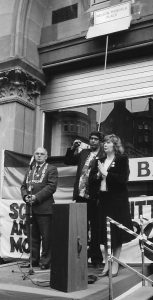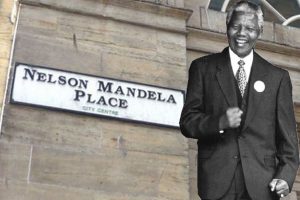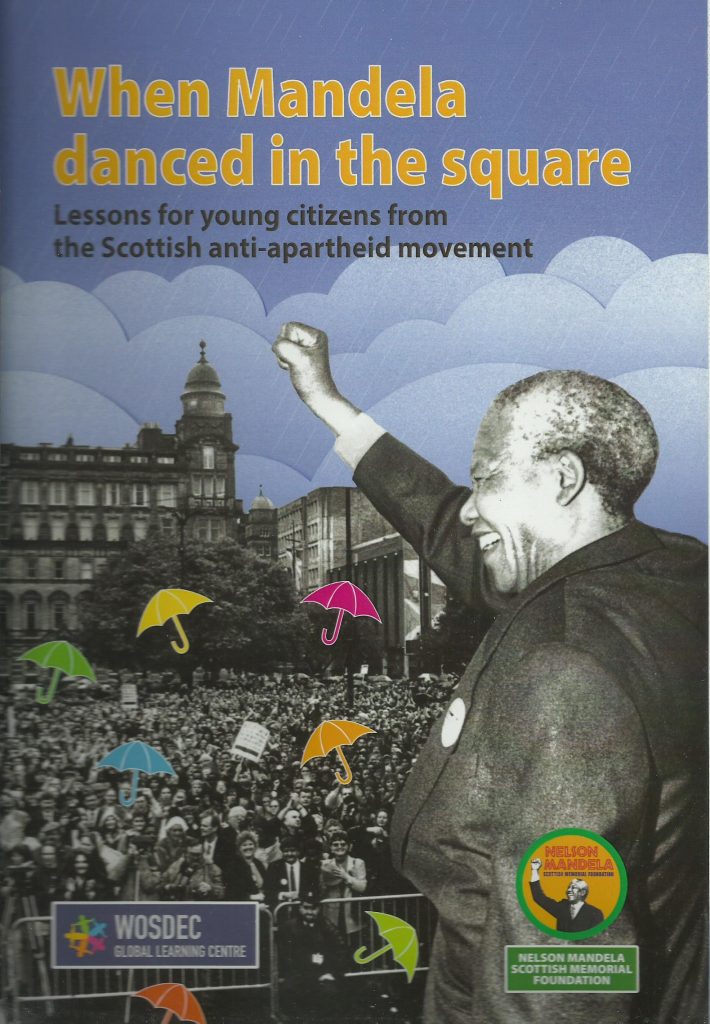On 16 June 1986 St George’s Place in Glasgow was re-named Nelson Mandela Place. This year is its 36th anniversary.
 This particular day of 16th June was chosen to commemorate the anniversary of the Soweto Uprising in South Africa.
This particular day of 16th June was chosen to commemorate the anniversary of the Soweto Uprising in South Africa.
The Soweto Uprising took place on 16th June 1976 when school students protested against the imposition of the Afrikaans language in schools. Afrikaans was the language of the Boers and was seen as the language of the oppressor.
Some of the peacefully demonstrating school students were shot and killed by the apartheid police including Hector Pieterson.
The photograph below, taken by Sam Nzima, of 12 year-old Hector being carried by Mbuyiso Makubo with Hector’s sister, Antoinette, running alongside, stunned the world yet again at the brutality of the apartheid regime.

The Soweto Uprising spread to other parts of the country involving thousands of young people and became a nationwide rebellion against apartheid.
A new generation of young South Africans had joined the movement against apartheid. It was a turning point in the struggle.
Following the end of apartheid in 1994, 16 June was designated South African Youth Day and is now a public holiday in South Africa.
Why did we re-name this particular street in Glasgow?
The Apartheid South African Consulate was housed there and we had picketed it for many years.
It was on the 5th floor of the Stock Exchange Building and Big Business continued to support apartheid as they made vast profits from South Africa because of its system of apartheid.
Therefore it was most appropriate to name this street Nelson Mandela Place. And as Billy Connolly, one of the Patrons of the Nelson Mandela Scottish Memorial Foundation, said, he “loved it”

Nelson Mandela released
Finally on 11 February 1990 after decades of struggle by the South African people and international solidarity Mandela was released after 27 years in prison.
And we celebrated in Nelson Mandela Place bringing traffic to a standstill that night. Here we are toasting the release of Nelson Mandela
 When Nelson came to Glasgow in 1993 I took him to the street named after him. He really liked that and it brought that famous Madiba smile to his face.
When Nelson came to Glasgow in 1993 I took him to the street named after him. He really liked that and it brought that famous Madiba smile to his face.
In 1994 Nelson Mandela became President of the new South Africa bringing an end to apartheid.
The Nelson Mandela Scottish Memorial Foundation has the twin aims of creating a statue in Nelson Mandela Place and of conducting educational work.
We have gained considerable support and we have now raised £120,000 towards the cost of the statue. We are now within striking distance of having enough money to create the statue of Nelson Mandela in Nelson Mandela Place. Please contribute and take us over the line!
Our educational work includes that of passing on to future generations the lessons of apartheid and its ‘crime against humanity’; the life and struggle of Nelson Mandela; his connection with Scotland and the solidarity that we shared with the South African people.
We are proud to support the Black Lives Matter movement which has shown the need to continue the struggle against racism, inequality and injustice. The statue of Nelson Mandela will be a continuing symbol of that struggle.

by Brian Filling
